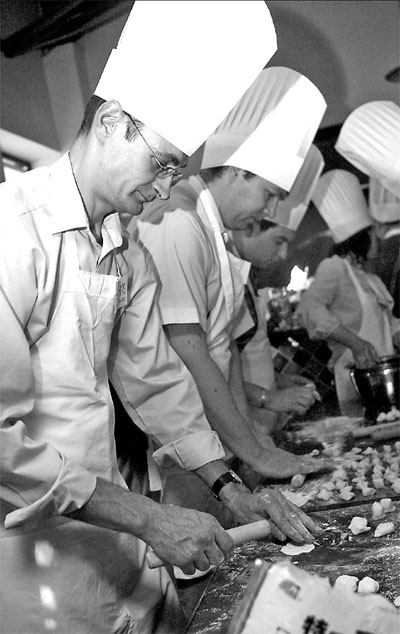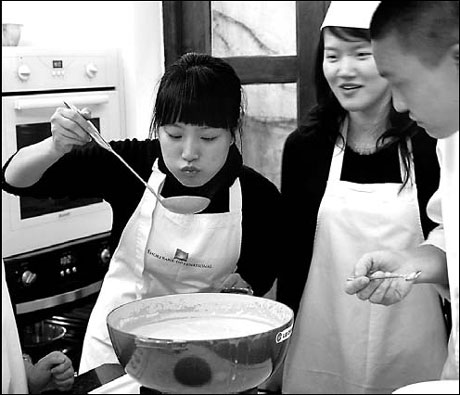Come fry with me
By Shi Yingying (China Daily)
Updated: 2010-05-03 08:56
 |
Large Medium Small |

Cooking parties that feature private cooking lessons with a professional chef and a semi-catered meal are proving a popular treat in Shanghai. Shi Yingying reports
It's a Wednesday morning in Cris & Manu's kitchen, where nine Japanese and Chinese housewives are listening attentively to Cristina Pisani, a private chef and caterer, talk about how to prepare sauces for risottos.
"I call it a spring vegetable sauce as it gives beautiful colors to your rice," says Pisani, holding up a carrot and an asparagus for the group's inspection.
Cooking parties like this - combining private cooking lessons with a semi-catered meal - have become very popular in Shanghai. Usually commissioned by an individual for a group, they are taught by chefs like Cristina Pisani and Manuela Guatelli either in their kitchens, or if preferred, in a private home.

"It's so trendy to cook at home now," says Pisani, who opened the Cris & Manu cooking studio in Shanghai three months ago with her business partner Manuela Guatelli. "Different from learning with cooking books, we offer an opportunity for tailor-made classes with plenty of guidance and attention."
The menu for a cooking party varies and is decided by the organizer and chefs before the party. Based on the wants and cooking skills of the participants, Pisani and Guatelli will devise an appealing no-fail menu.
"The good thing about it is that we don't have a set-menu," Pisani says. "It could be pasta with three different sauces or the whole menu with appetizer, main course and dessert."
A customized cooking class with plenty of personal attention for each participant is the first part of the party.
"We try to have the right number of people and right number of recipes in our class - around six to nine people maximum in one kitchen and make up to three recipes," Guatelli says. "Smaller is often better."
Pisani leads the women at this housewives' party, through the recipes, describing less familiar ingredients, demonstrating techniques and answering a variety of questions, including tips on where to shop locally.
Then the guests separate into teams of two, led by Pisani and Guatelli respectively, and start cooking an Italian risotto.
By noon the pace in the kitchen is relaxed but efficient, punctuated by the sound of vegetables being chopped and cream being beaten.
The event ended with the women tasting the food then packing up a portion of it to take home for their families.
"We usually have the class between 10:30 am to 1:30 pm, followed by a sit-down lunch," Guatelli says. "After cooking, we enjoy what we've prepared and talk about food across the world, inspiration for a new recipe or perhaps something completely different."
The kitchen gets noisier when some children arrive for a parents-and-children cooking class. "We had three mothers and three children come last Saturday for pie and cookie making," Pisani says. "It was a mess in the kitchen but everybody had fun."

Many enterprises, led by creative media and fashion companies, are starting to view cooking parties as a good way to build teamwork. "I know my team inside out in terms of client facing activities, but I never knew how they behaved in front of a chicken, until the day we went for a cooking class," says Christopher Woo, head of the stock photo company Corbis China.
"With a lot of laughter and a little bit of sweat, our team made four dishes from soup to dessert and I can attest that de-boning a chicken professionally requires no less skill than doing a cold call successfully."
This is what The Kitchen at Cooking Studio specializes in - throwing cooking party for dozens and even hundreds of people.
"If you can cook together, you can work together," says Miranda Yao, director of the big, neat kitchen located at Shanghai's Fu Xing Zhong Lu.
"We will include dishes that require a lot of teamwork into the menu for a corporate cooking party. For example, spring rolls stuffed with three delicacies needs lots of chopping, stir-frying and deep-frying from different team members," Yao says.
"Both Western and Chinese recipes are included as cross-cultural experiences are encouraged by many international companies. Classes inviting expats to cook small steamed buns and Chinese to make pasta are very popular."
Successfully holding cooking parties for clients such as IKEA, GE, HSBC and Chanel, The Kitchen at Cooking Studio sees a bright future for cooking parties, which are still a relatively new concept in China.
"These parties are the fastest growing part of my business," Yao says. "Nowadays people want fresh and fun activities where their efforts will be rewarded. Ideas like cooking parties meet these needs in three to four hours time."
Yao is also creative in terms of picking party venues. The biggest party they have hosted so far was for 129 people cooking simultaneously for a company's annual meeting this March. The venue was a huge film studio.
"This cooking party turned out to be something like a fashion show with the spotlights on our 'chefs'," she says happily.